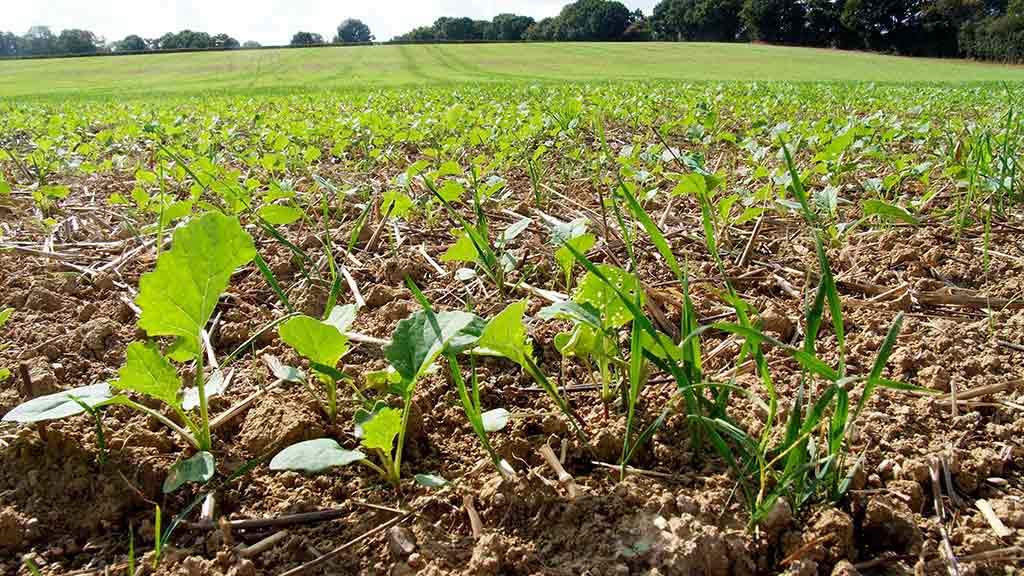Shrinking UK rapeseed area increases reliance on imports
 © Blackthorn Arable
© Blackthorn Arable A smaller planted area and flea beetle damaged crops have left the UK with a viable oilseed rape (OSR) area of between 305,000ha and 320,000ha for 2024, according to grower co-op United Oilseeds.
Total estimated planted area has dropped from about 413,000ha last year to 354,000ha this year, with about 10% to 15% of this thought to have been lost already due to cabbage stem flea beetle.
United Oilseeds announced at its annual conference that this could leave rapeseed production below 1m tonnes, based on average yields, which would be one of the lowest totals for many years.
See also: Large global supplies limit UK oilseed price rises
This is expected to leave the UK with a heavy reliance on imports during the coming year, with more than 1m tonnes of imported product forecast to be needed in order to satisfy demand.
United Oilseeds managing director James Warner said: “It’s been an incredibly challenging time for oilseed rape growers in the UK.
“Establishment issues, particularly due to cabbage stem flea beetle, followed by the terrible flooding we have seen across much of the East coast, has meant the crop has got off to a tough start, with some inevitable losses along the way.”
Mr Warner said there were still reasons to remain upbeat about the prospects for the OSR market in the UK, with domestic demand for rapeseed staying robust.
Growers continue to shift towards hybrid varieties, which now make up the vast majority of seed sales, while conventional seeds now account for about 22% of the market.
Anecdotally, some growers have been weighing up the risk of growing OSR and are considering putting land into environmental schemes instead, such as Mid Tier SFI, in order to receive a more stable return with less input.
UK production for harvest 2023 was estimated by United Oilseeds at 1.21m tonnes with yields averaging 3.1 t/ha.
Neonics
Speaking at the United Oilseeds event, NFU vice-president David Exwood said neonicotinoid seed dressings, prohibited for use in OSR crops grown in the UK, were still being used overseas with the products imported to the UK.
Herefordshire farmer Ally Hunter Blair said that on his own farm, yields had not recovered to levels before the neonics ban.
Market outlook
Owen Cligg, trading manager at United Oilseeds, was optimistic for prices into next year, with harvest prices for the 2024 crop currently between £370/t and £380/t ex-farm.
Mr Cligg told Farmers Weekly that poorer Brazilian crops due to hot weather in the north and rain in the south could offer some support to prices.
However, Argentina was likely to increase its soya planting significantly and the Australian crop was expected to be up next year, so it was a very dynamic situation.
The US Department of Agriculture’s World Agricultural Supply and Demand Estimates report on 9 November pointed to increased global soya bean production for 2023-24, with higher production forecasts in the US, Russia and Ukraine.
Sell or hold?
Asked whether growers should sell now or hold in expectation of better prices, Mr Cligg said: “The situation is that prices have improved recently, probably between £355/t and £360/t ex-farm for spot movement. If that gives them a return and they need cash, then yes, why not sell it.
“But if harvest is worth £370/t and harvest prices remain fairly strong, then there is limited downside, so it’s really all down to how they want to manage their own cashflow.”
Profits rise at United Oilseeds
United Oilseeds made a pre-tax profits of £2.86m (unaudited), up significantly on the previous financial year.
Turnover slipped marginally to total £217m.
The co-op intends to announce another record profits redistribution payment to its trading members in December.
